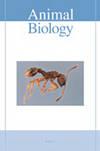利用闭路红外摄像机评估舍饲金丝燕的双亲喂养行为和觅食模式
IF 1.4
4区 生物学
Q2 ZOOLOGY
引用次数: 0
摘要
家养食用巢金丝燕(Aerodramus sp.)是一夫一妻制,用硬化的唾液筑巢,并利用回声定位在黑暗中导航。以往的研究大多集中于金丝燕的筑巢和孵化行为,但对繁殖期后代存活至关重要的雏燕供给行为仍不清楚。这项研究考察了马来西亚半岛中部一个金丝燕屋舍养殖场的金丝燕雏燕供养行为。研究人员详细分析了金丝燕觅食阶段的完整视频录像。随着雏燕年龄的增长,整个觅食期缩短。亲燕每天从黎明到黄昏交替到巢中哺育雏燕6-14次。这种活动的高峰期是7:00至8:00和19:00至20:00。雏鸟的喂养行为在不同的亲鸟对之间存在差异。有两只雏鸟的亲鸟的产卵间隔时间较长,这影响了第二只雏鸟的发育,因为第一只雏鸟能更成功地争夺食物,并长得更大。大多数体型较小的第二只雏鸟无法存活,因为它们被父母或兄弟姐妹有意或无意地淘汰了。存活下来的体型较小的第二只雏鸟的羽化时间比第一只雏鸟要长;因此,亲鸟必须加大觅食力度,以确保其雏鸟存活到羽化。这些行为可能受到年龄、经验、个体体质等生理因素以及天气和食物资源等非生物因素的影响;因此,在雏鸟觅食阶段,亲鸟可能会采取不同的策略。本文章由计算机程序翻译,如有差异,请以英文原文为准。
Using closed-circuit infrared camera to assess biparental provisioning behaviour and foraging pattern of house-farmed swiftlets (Aerodramus sp.)
The house-farmed edible-nest swiftlet (Aerodramus sp.) is monogamous, produces nests from hardened saliva, and uses echolocation to navigate in the darkness. Most previous studies have focused on swiftlet nest building and incubation behaviour, but nestling provisioning behaviour, crucial for the survival of offspring during the breeding season, remains unclear. This study examined the nestling provisioning behaviour of house-farmed swiftlets at a swiftlet house farm in central Peninsular Malaysia. Complete focal video footage of the provisioning phase of swiftlets was analysed in detail. The overall feeding period decreased as the chick grew older. The parents alternately visited their nest 6-14 times a day from dawn to dusk to feed the nestling. The peak of this activity was from 07:00 to 08:00 and between 19:00 and 20:00. Nestling provisioning behaviour differed between pairs. The egg-laying interval of parents with two chicks was longer and affected the development of the second chick since the first chick more successfully competed for food and grew larger in size. Most second chicks with a smaller body size did not survive, because of being either purposely or unintentionally eliminated by the parents or sibling. The smaller-sized second chicks that survived took a longer time to fledge than the first chick; therefore, parents had to increase their foraging effort to ensure the survival of their chick until fledging. These behaviours may be influenced by physiological factors, such as age, experience, individual fitness, and abiotic factors, such as weather and food resources; therefore, different parental strategies may be established during the nestling provisioning phase.
求助全文
通过发布文献求助,成功后即可免费获取论文全文。
去求助
来源期刊

Animal Biology
生物-动物学
CiteScore
2.10
自引率
0.00%
发文量
34
审稿时长
3 months
期刊介绍:
Animal Biology publishes high quality papers and focuses on integration of the various disciplines within the broad field of zoology. These disciplines include behaviour, developmental biology, ecology, endocrinology, evolutionary biology, genomics, morphology, neurobiology, physiology, systematics and theoretical biology. Purely descriptive papers will not be considered for publication.
Animal Biology is the official journal of the Royal Dutch Zoological Society since its foundation in 1872. The journal was initially called Archives Néerlandaises de Zoologie, which was changed in 1952 to Netherlands Journal of Zoology, the current name was established in 2003.
 求助内容:
求助内容: 应助结果提醒方式:
应助结果提醒方式:


